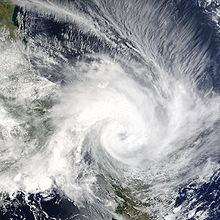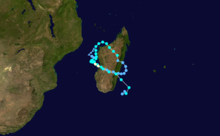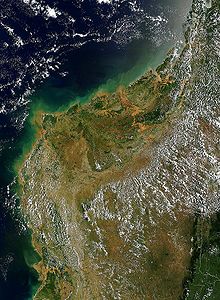- Cyclone Elita
-
Tropical Cyclone Elita Tropical cyclone (MFR) Category 1 cyclone (SSHS) 
Cyclone Elita on January 28 Formed January 26, 2004 Dissipated February 5, 2004 Highest winds 10-minute sustained:
120 km/h (75 mph)
1-minute sustained:
120 km/h (75 mph)
Gusts:
175 km/h (110 mph)Lowest pressure 970 mbar (hPa; 28.64 inHg) Fatalities 33 direct Areas affected Madagascar, Mozambique, Malawi, Seychelles, Mauritius, Réunion Part of the 2003-04 South-West Indian Ocean cyclone season Cyclone Elita was an unusual tropical cyclone that made landfall on Madagascar three times. The fifth named storm of the 2003–04 South-West Indian Ocean cyclone season, Elita developed on January 24 in the Mozambique Channel. It strengthened to become a tropical cyclone before striking northwestern Madagascar on January 28. Elita weakened to tropical depression status while crossing the island, and after exiting into the southwest Indian Ocean it turned to the west and moved ashore for a second time on January 31 in eastern Madagascar. After crossing the island, the cyclone intensified again after reaching the Mozambique Channel, and Elita turned to the southeast to make its final landfall on February 3 along southwestern Madagascar. By February 5 it underwent extratropical transition, and the remnants of Elita moved erratically before dissipating on February 13.
Elita dropped heavy rainfall of over 200 mm (8 inches), which damaged or destroyed thousands of houses in Madagascar. Over 50,000 people were left homeless, primarily in Mahajanga and Toliara provinces. Flooding from the storm damaged or destroyed more than 450 km² (170 sq mi) of agricultural land, including important crops for food. Across the island, the cyclone caused at least 33 deaths, with its impact further compounded by Cyclone Gafilo about two months later. Elsewhere, the cyclone brought rainfall and damage to Mozambique and Malawi, while its outer circulation produced rough seas and strong winds in Seychelles, Mauritius, and Réunion.
Contents
Meteorological history
An area of thunderstorms developed in the Mozambique Channel on January 25, 2004, about 95 km (60 mi) west of Madagascar.[1] Deep convection developed and organized around a mid- to low-level circulation,[2] and at 0600 UTC on January 26, Météo-France (MFR) classified the system as Tropical Disturbance 06, about 105 km (65 mi) west of Maintirano, Madagascar.[3] Six hours later, it was upgraded to Tropical Depression 06,[4] and later that day the depression was named Elita.[5] At the same time, the Joint Typhoon Warning Center (JTWC) began issuing advisories on the cyclone.[6] Strengthening at first was slow, due to moderate wind shear limiting the convection to the northern portion of the cyclone.[5] Initially, the storm tracked in an unusual northward motion toward the equator, which was caused by a ridge to its west.[7]
Early on January 27, Elita was upgraded to a moderate tropical storm,[8] though later that day it weakened to tropical depression status.[9] However, it quickly re-attained tropical storm status early on January 28,[10] with convection increasing further.[11] Elita turned east-southeastward due to a ridge to its north,[7] quickly intensifying as it approached land and developing a well-defined eye on visible satellite imagery.[12] It intensified to tropical cyclone status, or the equivalence of a minimal hurricane, at 1200 UTC on January 28.[13] Three hours later, Elita made landfall on Bombetoka Bay in northwestern Madagascar with wind gusts of over 180 km/h (110 mph).[14] The storm rapidly weakened to tropical depression status over land,[15] though as it crossed the island convection re-developed over the waters east of Madagascar. Elita reached the southwest Indian Ocean by January 30,[7] and its convection quickly organized into rainbands.[16] It drifted southward a short distance offshore, slowly intensifying before attaining tropical storm status at 0000 UTC on January 31.[7] About six hours later, after turning to the west, Elita moved ashore near Mananjary with winds of about 75 km/h (45 mph), as reported by MFR.[7][17]
The cyclone quickly weakened to tropical depression status as it tracked westward across Madagascar, and late on January 31 it emerged into the Mozambique Channel. Deep convection increased as it reached open waters, with outflow improving. A strengthening ridge to its north caused Elita to decelerate before turning to the east-southeast. Late on February 2, the JTWC assessed Elita with peak winds of 120 km/h (75 km/h), and shortly thereafter MFR reported the cyclone as attaining peak winds of 110 km/h (70 mph). Early on February 3, Elita moved ashore near Morondava at peak intensity. Weakening rapidly while crossing the island for a third time, the cyclone emerged into the southwest Indian Ocean as a tropical depression by 0000 UTC on February 4. Despite initial forecasts of re-intensification, Elita accelerated southeastward and lost its remaining convection, leaving its center exposed under the influence of a strong upper-level trough. By February 5, it had transitioned into an extratropical cyclone, and its motion had halted due to weak steering currents.[7] For about a week, the remnants of Elita meandered to the southeast of Madagascar before dissipating on February 13.[13]
Elita's crossing of Madagascar three times is unusual, but not unprecedented; Cyclone Felicie in January 1970 and Storm Justine in March 1982 accomplished the same feat.[14]
Impact
The Mozambique National Institute of Meteorology advised people living in Nampula, Zambezia, Sofala, and Inhambane Provinces to make preparations for strong winds and rainfall.[18] In Nampula province, over 2000 buildings were destroyed. The most severe damage was to generally poorly built houses in Memba, Nacala-a-Velha, Mogincual, and Nampula city. In the latter city, an Islamic school was badly damaged, and in Nacla-a-Velha survivors had to spend the night of January 29 in the open.[19] All in all, Elita impacted four provinces of Mozambique. Much of the impact was along the coast from Inhambane to Nampula.[18] The inflow of the storm brought moisture from the Intertropical Convergence Zone through Malawi, which produced heavy rainfall of over 150 mm (6 in); the rainfall destroyed more than 80 houses and a clinic in Karonga district. The storm brought rough seas, gusty winds, and some precipitation to the southwestern islands in Seychelles.[14]
Upon making its first landfall on Madagascar, Elita dropped heavy rainfall along its path, peaking at 715 mm (28.1 in)[20] including a 24 hour total of 222 mm (8.74 in) in Antsohihy. Wind gusts reached over 180 km/h (110 mph) in Mahajanga.[14] The passage of the cyclone left 5,000 people homeless in the vicinity of its first landfall, with 90 percent of the buildings in northwestern Mahajanga Province damaged by the storm. At least two people were killed in the region.[21] Throughout the country, Cyclone Elita destroyed or severely damaged 12,408 homes,[22] which left 55,983 people homeless,[14] primarily in Mahajanga and Toliara.[23] This forced around 7,000 people to seek shelter in either stadiums or in the remaining standing buildings. Additionally, a total of 510 schools and hospitals received major damage. The cyclone affected five of the six provinces of Madagascar, with roads and power being severely disrupted in some areas;[22] at least 39 bridges were damaged or destroyed.[23] The cities of Maintirano and Soavinandriana were both severely damaged.[14] In Midongy Atismo, heavy rainfall flooded 80% of the town's rice crop,[24] and the corn and manioc crops were both similarly affected. These represent the staple foods of the population,[22] and across the nation the storm damaged more than 450 km2 (170 sq mi) of agricultural land.[25] Throughout Madagascar, the cyclone killed at least 33 people and injured 129 others.[14]
The extratropical remnants of Elita produced rough seas and strong winds on Mauritius and Réunion island, which caused one ship to sink.[7]
Aftermath
On February 13, 2004, officials in Madagascar issued an appeal for international aid.[26] By a month after the storm, the governments of France, United States, Germany, and Japan sent a total of $287,000 (2004 USD) in assistance.[25][26][27][28] The government of France sent a plane with food, medicine, and other equipment to the affected areas.[26] The government of Germany sent aid to be used for foods and medicines.[27] On February 27, the government of Japan sent aid to the country, including tents, generators, and plastic sheets.[28]
Officials distributed emergency relief items to the impacted areas, including rice, sugar, soap, candles, matches and water purification tablets. In Morondava in Toliara Province, the government distributed 4 tons of rice seed, while in Ambatolampy in Antananarivo Province, the government sent 10 tons of rice; additionally, the World Food Programme sent 80 tons of flour to the nation. The combined efforts of the United Nations and aid agencies repaired the schools and distributed meals to the families affected by the disaster. Workers in association with the Madagascar Red Cross set up a water system that provided about 45,000 litres (11,900 gallons) of drinkable water per day.[22]
The impact of Cyclone Elita was severely compounded by Cyclone Gafilo about two months later, which killed hundreds and left over 240,000 people homeless.[14]
See also
References
- ^ Mohammed, Dixon, Jacobs, & Schultz (2004). "January 25 Significant Tropical Weather Advisory". Joint Typhoon Warning Center. ftp://ftp.met.fsu.edu/pub/weather/tropical/GuamStuff/2004/Jan/2004012510-ABIO.PGTW. Retrieved 2008-01-14.
- ^ Mohammed, Dixon, Jacobs, & Schultz (2004). "January 26 Significant Tropical Weather Advisory". Joint Typhoon Warning Center. ftp://ftp.met.fsu.edu/pub/weather/tropical/GuamStuff/2004/Jan/2004012613-ABIO.PGTW. Retrieved 2008-01-17.
- ^ La Réunion - Météo-France (2004). "Tropical Disturbance 06 Advisory 1". ftp://ftp.met.fsu.edu/pub/weather/tropical/Seychelles/2004/Jan/2004012606-FMEE. Retrieved 2008-01-17.
- ^ La Réunion - Météo-France (2004). "Tropical Depression 06 Advisory 2". ftp://ftp.met.fsu.edu/pub/weather/tropical/Seychelles/2004/Jan/2004012612-FMEE. Retrieved 2008-01-17.
- ^ a b La Réunion - Météo-France (2004). "Tropical Depression 06 (Elita) Advisory 3". ftp://ftp.met.fsu.edu/pub/weather/tropical/Seychelles/2004/Jan/2004012618-FMEE. Retrieved 2008-01-17.
- ^ Joint Typhoon Warning Center (2004). "Advisories for Tropical Cyclone Elita". http://www.australiasevereweather.com/cyclones/2004/elita.htm. Retrieved 2008-01-18.
- ^ a b c d e f g Gary Padgett (2004). "January 2004 Worldwide Tropical Cyclone Summary". http://www.australiasevereweather.com/cyclones/2004/summ0401.htm. Retrieved 2008-01-18.
- ^ La Réunion - Météo-France (2004). "Tropical Storm Elita Advisory 4". ftp://ftp.met.fsu.edu/pub/weather/tropical/Seychelles/2004/Jan/2004012618-FMEE. Retrieved 2008-01-17.
- ^ La Réunion - Météo-France (2004). "Tropical Depression 06 (ex-Elita) Advisory 6". ftp://ftp.met.fsu.edu/pub/weather/tropical/Seychelles/2004/Jan/2004012718-FMEE. Retrieved 2008-01-18.
- ^ La Réunion - Météo-France (2004). "Tropical Storm Elita Advisory 8". ftp://ftp.met.fsu.edu/pub/weather/tropical/Seychelles/2004/Jan/2004012800-FMEE. Retrieved 2008-01-18.
- ^ La Réunion - Météo-France (2004). "Tropical Storm Elita Advisory 9". ftp://ftp.met.fsu.edu/pub/weather/tropical/Seychelles/2004/Jan/2004012806-FMEE. Retrieved 2008-01-18.
- ^ La Réunion - Météo-France (2004). "Tropical Storm Elita Advisory 10". ftp://ftp.met.fsu.edu/pub/weather/tropical/Seychelles/2004/Jan/2004012812-FMEE. Retrieved 2008-01-18.
- ^ a b La Réunion - Météo-France (2004). "Forte Tempete tropicale: Elita" (in French). http://www.meteo.fr/temps/domtom/La_Reunion/TGPR/saison20032004B/05.html. Retrieved 2008-01-21.
- ^ a b c d e f g h RA I Tropical Cyclone Committee for the Southwest Indian Ocean (2005). "Seventeenth Session for the Tropical Cyclone Committee" (PDF). World Meteorological Organization. http://www.wmo.int/pages/prog/www/tcp/documents/RAITCC-17En.pdf. Retrieved 2008-01-18.
- ^ La Réunion - Météo-France (2004). "Tropical Depression Elita Advisory 12". ftp://ftp.met.fsu.edu/pub/weather/tropical/Seychelles/2004/Jan/2004012900-FMEE. Retrieved 2008-01-19.
- ^ La Réunion - Météo-France (2004). "Tropical Disturbance 06 (ex-Elita) Advisory 17". ftp://ftp.met.fsu.edu/pub/weather/tropical/Seychelles/2004/Jan/2004012900-FMEE. Retrieved 2008-01-19.
- ^ La Réunion - Météo-France (2004). "Tropical Storm Elita Advisory 20". ftp://ftp.met.fsu.edu/pub/weather/tropical/Seychelles/2004/Jan/2004013100-FMEE. Retrieved 2008-01-19.
- ^ a b "Tropical storm affects Mozambique". Xinhua News Agency. 2004-02-03. http://www.reliefweb.int/rw/rwb.nsf/db900sid/OCHA-64DJQS?OpenDocument&rc=1&emid=ST-2004-0029-MDG. Retrieved 2008-01-20.
- ^ "Storm hits Nampula province of Mozambique". Xinhua News Agency. 2004-01-30. http://www.reliefweb.int/rw/rwb.nsf/db900sid/ACOS-64CLUN?OpenDocument&rc=1&emid=ST-2004-0029-MDG. Retrieved 2008-01-20.
- ^ "Cyclone Elita (09S) Cumulative Track and rainfall" (PDF). National Oceanic and Atmospheric Administration. 2004. http://www.cpc.ncep.noaa.gov/products/fews/CYCLONES/elita_track.pdf. Retrieved March 10, 2011.
- ^ Joint Typhoon Warning Center (2005). "Report on Tropical Cyclone Elita (09S)". http://www.usno.navy.mil/NOOC/nmfc-ph/RSS/jtwc/atcr/2004atcr/SH/StormSH/SH09.html. Retrieved 2008-01-20.
- ^ a b c d International Federation of Red Cross And Red Crescent Societies (2004-03-03). "Madagascar: Cyclone Elita Information Bulletin No. 1". ReliefWeb. http://www.reliefweb.int/rw/rwb.nsf/db900sid/OCHA-64C95J?OpenDocument&rc=1&emid=ST-2004-0029-MDG. Retrieved 2008-01-20.
- ^ a b Action by Churches Together International (2004-02-27). "ACT Appeal Madagascar: Cyclone Relief AFMG-41". http://www.reliefweb.int/rw/rwb.nsf/db900sid/ACOS-64CE7E?OpenDocument&rc=1&emid=ST-2004-0029-MDG. Retrieved 2008-01-20.
- ^ Integrated Regional Information Networks (2004-02-16). "Aid urgent after Elita sows destruction". United Nations Office for the Coordination of Humanitarian Affairs. http://www.reliefweb.int/rw/rwb.nsf/db900sid/OCHA-64BNX2?OpenDocument&rc=1&emid=ST-2004-0029-MDG. Retrieved 2008-01-20.
- ^ a b Tamra Halmrast-Sanchez (2004). "Southern Africa Information Bulletin #2" (PDF). United States Agency for International Development. http://www.usaid.gov/our_work/humanitarian_assistance/disaster_assistance/countries/southern_africa/fy2004/SouthernAfrica_UP_IB02-05-21-2004.pdf. Retrieved 2008-01-20.
- ^ a b c Agence France-Presse (2004-02-13). "Madagascar seeks aid after storm kills 29, leaves 44,000 homeless". http://www.reliefweb.int/rw/rwb.nsf/db900sid/OCHA-64C6JD?OpenDocument&rc=1&emid=ST-2004-0029-MDG. Retrieved 2008-01-20.
- ^ a b Government of Germany (2004). "Federal Foreign Office makes available 70,000 euro for victims of the tropical cyclone "Elita" in Madagascar". http://www.reliefweb.int/rw/rwb.nsf/db900sid/ACOS-64CC6F?OpenDocument&rc=1&emid=ST-2004-0029-MDG. Retrieved 2008-01-20.
- ^ a b Ministry of Foreign Affairs of Japan (2004-02-27). "Emergency Assistance to Madagascar for Cyclone Disaster". http://www.mofa.go.jp/announce/announce/2004/2/0227-2.html. Retrieved 2008-01-20.
Categories:- 2003–04 South-West Indian Ocean cyclone season
- 2004 in Madagascar
- Cyclones in Madagascar
- South-West Indian Ocean tropical cyclones
Wikimedia Foundation. 2010.



